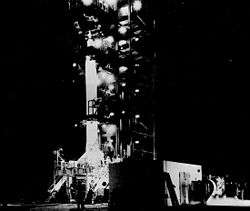Vanguard TV0

Vanguard TV-0, also called Vanguard Test Vehicle Zero, was the first sub-orbital test flight of a Vanguard rocket as part of the Project Vanguard.
Project Vanguard was a program managed by the United States Naval Research Laboratory (NRL), and designed and built by the Glenn L. Martin Company (now Lockheed-Martin), which intended to launch the first artificial satellite into Earth orbit using a Vanguard rocket, powered by a basic design for large liquid rockets.[1] as the launch vehicle from Cape Canaveral Missile Annex, Florida.
Vanguard TV-0 was a refurbished Viking 13 rocket. Vanguard TV0 was only a one-stage test flight. It was launched 8 December 1956 at l:05 a.m at Cape Canaveral from launch pad 18A. A Viking launch stand was shipped from White Sands Missile Range for use at the Cape Canaveral. The one stage flight test was to prepare for the late launch of the full three-stage Vanguard. One of the goals of the test was to test the new Minitrack transmitter used as part of the tracking systems. Shortly after two minutes after lift off a small telemetry antennas unrolled from the rocket transmitting an oscillator's beep. The beep was picked up at the Air Force Missile Test Center's (AFMTC) tracking station.
Vanguard TV-0 was very successful, the one stage rocket achieved an altitude of 126.5 mi (203.6 km) and a down range of 97.6 mi (157.1 km), landing in the Atlantic Ocean. Vanguard TV-0 was followed by Vanguard TV-1. Vanguard TV-1 was a successful two stage prototype rocket.[2][3][4][5] With Vanguard TV-0 success, the next sub-orbital test flight, Vanguard TV1, was launch on May 1, 1957.
Background
Vanguard TV-0 success was an important part of the space race. The space race started between United States and the Soviet Union at the end of World War 2, as a race began to retrieve as many V-2 rockets and Nazi Germany V-2 staff as possible.[6] Three hundred rail-car loads of V-2 rocket weapons and parts were captured and shipped to the United States, also 126 of the principal designers of the V-2, including Wernher von Braun and Walter Dornberger, went to America. Von Braun, his brother Magnus von Braun, and seven others decided to surrender to the United States military in Operation Paperclip to ensure they were not captured by the advancing Soviets or shot dead by the Nazis to prevent their capture.[7] Thus the V-2 program started the space race, the V-2 could not orbit, but could reach a height of 88 km (55 mi) on long range trajectory and up to 206 km (128 mi) if launched vertically.[8][9][10]
Due to later problems with Vanguard it was not the first rocket to into orbit an unmanned satellite. The first small-lift launch vehicle was the Sputnik rocket, it put into orbit an unmanned orbital carrier rocket designed by Sergey Korolyov in the Soviet Union, derived from the R-7 Semyorka ICBM. On 4 October 1957, the Sputnik rocket was used to perform the world's first satellite launch, placing Sputnik 1 satellite into a low Earth orbit.[11][12][13] The USA responded by launching the Vanguard rocket,[1][14] that was intended to be the first launch vehicle the United States would use to place a satellite into orbit. Instead, the Sputnik crisis caused by the surprise launch of Sputnik 1 led the U.S., after the failure of Vanguard TV3, to quickly orbit the Explorer 1 satellite using a Juno I rocket launched on January 31, 1958. Thus Vanguard I was the second successful U.S. orbital launch. Thus started the space race, that gave the drive to put men on the moon with the USA's Apollo program.[15][16]
See also
- Vanguard rocket
- Project Vanguard
- Comparison of orbital launch systems
- Comparison of orbital rocket engines
- Rocket
- Spacecraft propulsion
References
- 1 2 "The Vanguard Satellite Launching Vehicle — An Engineering Summary". B. Klawans. April 1960, 212 pages. Martin Company Engineering Report No 11022, PDF of an optical copy.
- ↑ "NASA History, Chapter 10". history.nasa.gov. Retrieved 24 December 2015.
- ↑ Project Vanguard: The NASA History, By Constance McLaughlin Green, Milton Lomask
- ↑ "U.S. space-rocket liquid propellant engines". www.b14643.de. Retrieved 24 June 2015.
- ↑ Winter, Frank H. (1990). "3 — Rockets Enter the Space Age". Rockets Into Space. Harvard University Press. p. 66. Retrieved 24 June 2015.
- ↑ "We Want with the West", Time Magazine, 9 December 1946.
- ↑ "Wernher von Braun". Retrieved 4 July 2009.
- ↑ "Bumper Project". White Sands History - Fact Sheets and Articles. US Army. Archived from the original on 10 January 2008. Retrieved 2 December 2007.
- ↑ 'Long-range' in the context of the time. See NASA history article.
- ↑ Neufeld, Michael J (1995). The Rocket and the Reich: Peenemünde and the Coming of the Ballistic Missile Era. New York: The Free Press. pp. 158,160–2,190.
- ↑ "NASA - NSSDC - Spacecraft - Details – Sputnik 1". nssdc.gsfc.nasa.gov. Retrieved 24 December 2015.
- ↑ "Sputnik launch vehicle 8K71PS (M1-1PS)". russianspaceweb.com. Retrieved 24 December 2015.
- ↑ (Russian) Sputnik Rocket
- ↑ Kennedy, John F. (20 April 1961). "Memorandum for Vice President". The White House (Memorandum). Boston, MA: John F. Kennedy Presidential Library and Museum. Retrieved 1 August 2013.
- ↑ Launius, Roger D. (July 1994). "President John F. Kennedy Memo for Vice President, 20 April 1961" (PDF). Apollo: A Retrospective Analysis (PDF). Monographs in Aerospace History Number 3. Washington, D.C.: NASA. OCLC 31825096. Retrieved 1 August 2013. Key Apollo Source Documents.
External links
Further reading
- Mallove, Eugene F. and Matloff, Gregory L. The Starflight Handbook: A Pioneer's Guide to Interstellar Travel, Wiley. ISBN 0-471-61912-4.